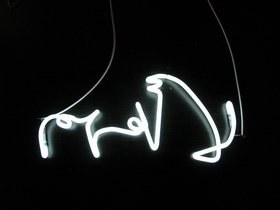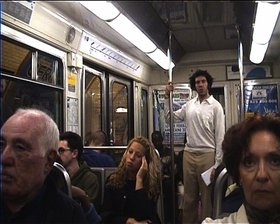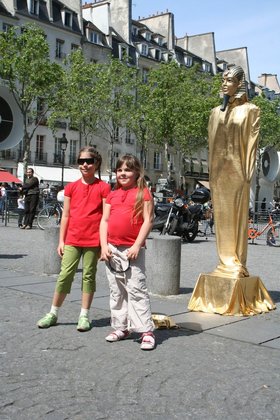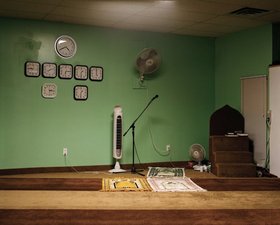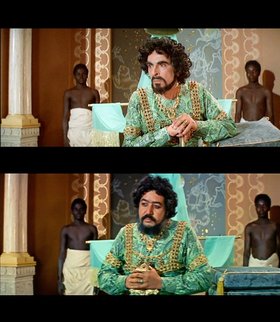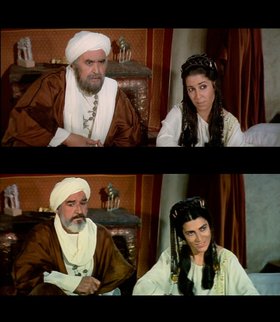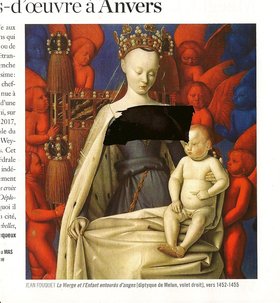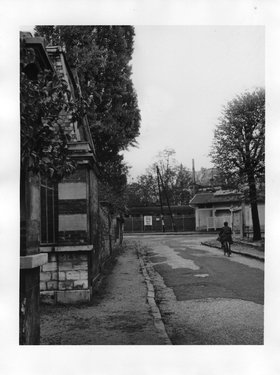Interviews
Restaging Invisibilities
Fayçal Baghriche in conversation with Laura Allsop
Fayçal Baghriche's work – which takes in performance, video, installation and photography – makes interventions into our ingrained patterns of perception, deploying subtle gestures that briefly turn our assumptions about the rhythms of city life, for instance, on their head. Whether recording himself reading out his CV in hopes of getting work on a crowded Paris metro (in the work Le Marché de L'emploi, 2003), or bamboozling tourists into thinking that a statue of Tutankhamun is a street artist (Philippe, 2008), his work invites us to think about the ways in which we navigate and scan the city, what we notice and, crucially, what we filter out.
In his most recent work, as he tells Ibraaz's Managing Editor Laura Allsop, he has been looking back to his Muslim roots and creating works that either actively look to the Middle East from a western perspective (as in photography series Musallat, in which the camera lens is pointed at the Kaaba in a variety of prayer rooms in Canada) or engage with the two perspectives together. An example of the latter would be Baghriche's film work The Message Project, in which the artist spliced together scenes from the English and Arabic versions of 1977 film The Message into one seamless film.
During a recent residency in Dubai, Baghriche also became interested in censored images he found in imported magazines, with images of nudity tastefully covered up with black calligraphic marks. These found images form the basis of a new body of work entitled Family Friendly, 2012, a selection of images from which are available to view in an online 'book' published here on Ibraaz.
Laura Allsop: Thinking broadly about your practice, while you work with a variety of media, your works tend to pivot around these subtle gestures and juxtapositions that invite the viewer to think about the space they're inhabiting and also their ingrained social behaviours. And the reaction from the public to these gestures is often quite subtle as well – how do you choose to intervene in the spaces in the first place?
Fayçal Baghriche: When I began my practice I didn't have any money to do difficult things. When I say I didn't have any money, I mean really nothing, I didn't have a studio, I didn't have money to buy tools, so the only thing I had was my body and I knew how to practice with my body, because I have a performance art background. It was my principle medium, in fact. My drawing is really bad, my painting is awful, I'm not a 'traditional' artist as you would imagine one but at the same time making art was really important for me, even a necessity. It was a political gesture, to make art with the only thing that I had, which was my body. And after a period, when things began to improve, I began to have more things at my disposal – a camera and a computer, for example – and I began to make edited videos, which was easier. I'm making artworks in the same way that I would make words, or sentences. It begins with the words and I always think about a rhetoric, about manipulating ideas, which in turn creates the work.
LA: There are elements of the uncanny as well: yours aren't dramatic interventions, but they definitely invite a double-take.
FB: Yes, most of the time, this way of working is related to science fiction novels, not so much the idea of making science fiction as such but the idea of what you see before you being somehow different. If what you are seeing could be changed or if what you see is not the real situation, it is like an inversion of reality. You can put in a lot of effort and take a lot of time – or you can just make the right thing really briefly at the right moment, and that has been my way of making art for many years now. It's about saying the right thing, in the shortest amount of time. That's how my work Philippe (2008) functions, and also Facing Forward (2002). You can relate this to all my work, all of them are linked by this procedure or way of thinking.
LA: You mentioned that as your practice developed, you acquired more tools, a camera for instance. And I'm interested in the idea of recording these brief moments in time, where what you want to say is delivered in a very economical way. I wonder about this need to document not just these moments but also the reactions of the public to them – such as in your work Le Marché de L'emploi (2003), where you record yourself on a Paris metro train reading out your CV to nonplussed commuters.
FB: These videos, these documents, are a pretext to filming other people. I'm just a point in the image that explains the image, you see me and the work and you may find it interesting, but behind that you see people. I am the principle character in my videos, but it's not because I want to talk about me, it's just the easiest, most economical way of doing that - because I'm here, I do it. Again, this is about the performative element in my work. If I know someone else who can act, fine, I can substitute my body for theirs, I don't mind. But in Le Marché de L'emploi, you see that I am replacing my body, it is not Fayçal Baghriche's body, but that of a 'struggling artist' having a difficult time in Paris. This is the body of someone who has difficulties in life, something you see in the Paris metro all the time. It's an aberration of sorts, you're meant to see someone singing or making music or asking for money, but you're not supposed to see someone putting themselves forward for a job. It's a replacement – I took this person and replaced it with a different person, one situation for another. In Philippe also, you are laughing because you see people doing something that you also could do, and because you know what is happening, there's dramatic irony, you know something they don't. They are urban works, taking people and showing how they are and making a portrait of the city. Even in some work, where you don't see it in explicit terms, you can see my work is related to the people in the city, the workers and the tourists. But I think this is to do with my theatrical background. I used to live in Nice and I worked in theatre there and I used to sit in cafes in the sun and people-watch.
LA: These videos are very much tailored to the city, and depict very particular situations, people on the metro asking for money, or street artists masquerading as sculptures. But there's a double inversion happening – the first time I ever saw someone dressed as Tutankhamun, in Rome I think, I panicked as soon as I saw them move, because I thought it was a sculpture. After that I got used to seeing these live statues around. But you turning the figure back into a sculpture plays with our received expectations and forms of behaviour that you only get in the city.
FB: It's funny, when it came to Philippe, children knew that it was a sculpture, they didn't think it was a human. You come across many Tutankhamuns in cities around the world, why? For me, Tutankhamun is like a 'ground zero' of live statuary – you begin with Tutankhamun, because it's the easiest way to make a live statue, it's an easy posture and you wear a mask. I like this idea of an antique sculpture related to a live statue, linked by this level in visual art and performing art.
LA: You were talking earlier about your practice of observing people and it struck me that your work is less about disturbing or disrupting normal urban patterns but rather asking what it is that people see when they walk around the city, what they notice and what they filter out. I wonder if you could relate that back to your idea of observing people and their habits?
FB: What I can say is that it's not only related to my theatrical background, but also to my visual art background; that is, watching the city. I'm not focused on the people, but the general ambience of the city. When you go to art school, you are taught many things and afterwards when you go out into the city, you see it completely differently. This phenomenon is really interesting. Your teacher shows you that what you are seeing is not really what you are seeing. When you go out with your friends – and this is an exercise I like doing – you observe things and you point things out. You make strange relations, you find symbols in things, and you question and try to understand how people who organise the city think. You have a practice and they have a practice and you understand that someone has thought about it and drawn it. So you have a relation with the people who create the environment, you look at architecture with someone else's eyes, you look at urbanism with another set of eyes. And it's something you do with friends, scanning for this and that. You're looking out not for the normal situations but for the abnormal, the monsters of the city.
LA: On your website, you note that you grew up in two cultures; you say that you navigated 'an Arab culture in the private sphere and a western culture in the public sphere'. I wondered if you could relate this statement to two series, your Musallat (2010) series of photos that picture empty prayer rooms in buildings in Canada, and also in your work The Message Project (2010) where you splice together scenes from the English and Arabic versions of Moustapha Akkad's 1977 film The Message, about the birth of Islam.
FB: Musallat re-links my western culture with my original culture. There is something happening with this work, in my way of thinking, my personality and my presence in the work. It's quite an important one for me. I also made it during Ramadan, in Montreal, and I was fasting. I was in the same situation as many, many Muslim people. And I was going to these prayer rooms. I had been to prayer rooms as a child, in Algeria. I would pray for three months during my holidays there, and when I came back to France, I would stop. I have a lot of attachment to religion and what it can be in my practice. Musallat is a step forward, with religion and prayer. It is really related to something that I left behind. I was born in Algeria, into a Muslim culture, and I grew up in France. When you grow up in the west, you look west, you don't look east or south, you don't want to. You are in France, you look towards America. But that was in the twentieth century. Now, in the twentyfirst century, things have changed. We know the situation in America, the ascendancy of China and the Middle East and what I wanted to say is that our way of looking, our direction, has changed. You really feel that it was there and now it's over there. Muslims also always look towards Kaaba, to Mecca, and changing the direction of the camera – which is me, my eyes, my soul – is an important way of evolving my practice. When I was a student and after, I really didn't want to be in a category of Arab artists, making 'Arab' works. I wanted to make international art, I didn't want to an 'ethnic'. That's a large part of my work, this idea of post-nationalism. I'm not saying I'm French or Algerian – I mean, it means something to me, but I'm not proud of any flag or country. But recently, I have come to admit that I have a culture, and because of that culture and background, certain works appear, my personal references come out whether I like it or not and sometimes I want to make some works related to Islam and to Algeria. However, I'm the common denominator.
LA: Relating that to The Message Project, how did you decide on the sequence – which bits would be in English, which would be Arabic? Were there chance elements, or were you following a set protocol?
FB: It's related to character. For example, the Uncle of the Prophet, he will be Anthony Quinn. But the bad guy, Abu Sofyan, he would be Michael Ansara. I related one character to one actor, so it would be Anthony Quinn every time for the character of Hamza. So when you see the movie, you know his character is the same. Sometimes, though, he can change. For example, there is a scene where Quinn's character becomes very angry, he punches someone, and he becomes so angry that he becomes an Arab. There is another scene, where he dies, and he changes face and becomes the other actor. It's not cutting, just the mood of the action. You have different characters in one character, and it's a little bit schizophrenic – always English, but sometimes Arab, or it could also be the other way around. I made many tests and decided to keep certain characters the same throughout. What I wanted to see was a movie that you can watch as a real movie, from beginning to end.
LA: It's interesting that you chose to edit them together, because someone else might have chosen to play both films simultaneously on two facing screens and kept them separate but in dialogue.
FB: I was thinking about that at the beginning. I think Pierre Huyghe did something similar, played two old movies at the same time. I was thinking a lot about what would be the best way to present these films. But because they were almost exactly the same film, it was possible to edit them together, so I though, let's do it.
LA: How did you come across the film, had you seen it when you were younger?
FB: Everyone in the Arab world knows this movie, it's like if I asked you if you have seen The Ten Commandments (1956). Even if you haven't seen it, you know of it. So if you grew up in an Arabic country, you would see this movie every year on TV. This is the equivalent of the Christmas movie. And they made it that way especially. Muslim people are really proud of this film; it's their version of the big Hollywood epic. In fact, the work actually reveals how I rediscovered it. It relates to my past and particularly my childhood, my parents' house and my Arab culture, which I left behind. I got the film from an Arabic library, and you have a few of these Muslim areas in Paris, where they have Qurans and copies of The Message. And I'd never been into one of these places before; it was part of the old world I wasn't really interested in. But I went with my wife, who encouraged me to go in and saw that they had the double DVD of The Message, a special edition with both English and Arabic versions. I knew that both versions existed, but I had never seen them both together.
LA: You mentioned your A.i.R residency in Dubai and the work you made for it, called Family friendly (2012), which relates to magazine images you collected that have been censored with black marks. I wanted to talk to you about these images and about the aesthetics of censorship – how do the censors work?
FB: The way that they do it in fact is with a black calligraphic pen. It's considered sacrilege in the west, to do this to iconic images of art featuring nudity. For me, when I see these censored images – because I have a Muslim background – I see that it's done in a respectful way. It's handmade, it's real people who do it with their hands; they are in a sense artists. And I'm sure that there are artists who do this for a living. It's what I would do if I were an artist in the UAE, I would relate it to my practice. And they do it very well; you can see from one magazine to another that the style of censorship is quite consistent.
LA: And are they western magazines we're talking about?
FB: The ones that I found were imported. I do it with many different ones. I have 10 at the moment. You can see how well they hide the images, they might put a skirt on someone – it's very subtle and respectful. But I'm not judging at all, for me, a nude is a western way of art. If you were to erase the nude from western art history, you wouldn't have much left. But in Muslim culture, there are no nudes in art and it's new to even depict the body at all. For Muslims, it's sacrilegious to see female décolletage in a magazine, for example. And it's not just nudity but the presentation of people in imagery in general. It's a question of privacy and of boundaries between the private and public realms. The two are not connected.
LA: So is the work less about censorship than about the sacred and profane and how the concepts of both change from culture to culture?
FB: This is a layer that you can extrapolate. But my purpose with this work is related to two ways of thinking in my practice, the strand interested in Islam, but also the one interested in works made by other artists or by other people not necessarily artists at all. I have a few works like that. I refer this new work to another one called Imperfections (2010), for which I went to my framer and asked him to give me pieces of glass with imperfections marked in pen – it's the same process, the same format and this is work where I don't do anything. I just take the object and I frame it. It's re-appropriation. This new work is very much related to this idea. The images in the magazines were of famous artworks, which are amazing, but something else happens: the status of the image changes when it is censored. In another work, Leap into the void (2005), I Photoshopped the figure of Yves Klein out of his famous image Le Saut dans le Vide (Leap into the Void), 1960. There is no body any more. And it's related to my work and my culture – for example in The Message, where you cannot see the Prophet, even though the film is all about the birth of Islam. The iconoclast culture is really very present. When I did Leap into the void, I didn't realise that it was related to my Islamic culture, but in fact it is. Suddenly, it all made sense. I have a small collection of these magazine images from Dubai; there are some that are encased in these coloured folders. In the supermarket, you cannot see the bodies of women on the covers of magazines, so they put them in these folders, and you have just the faces showing. And it's an abstraction of the image. The first one I got from Bahrain was black, so you have these black or coloured squares with faces poking out the tops. It's interesting, especially having grown up in France, which is the country of the nude.
Something further I'd like to add: I did three works in Dubai, this Family Friendly work, one called Nothing More Concrete (2012), which is dry plaster-board, and another one called Nothing More Real (2012), which is a reproduction of two incense burners stationed at the fair. These last two were both made using plasterboard, a basic building material. They are like invisible works, people don't really see them. Nothing More Real looks like the two other incense burners, which are made of stone, but unfinished. What you see in this work is just surface and because it's close to the two others, you can imagine the others are just surface as well. And because they are made of stone and the building is made with the same stone, you can also ask if the building you see is also empty and false, like Las Vegas. So I'm going back to Philippe and this question of noticing your surroundings and materials, that what you see may not be the truth.
LA: And does that relate as well to the notion of disappearance we discussed earlier?
FB: Yes, but more about invisibility. On the day of the opening, people were sitting on my sculpture and they didn't realise that this was a work. And when people asked me what did I do for the fair, I told them about the piece and they didn't realise. This type of reaction made me really happy. And it's a lot like Philippe.
Fayçal Baghriche (b.1972) grew up between two cultures, navigating an Arab culture in the private sphere and western culture in the public realm. Baghriche has a diploma in Fine Arts from La Villa Arson, Nice and a BA in Dramatic Arts from Sophia Antipolis, Nice and an MA in Multimedia Creation from the National School of Fine Arts in Paris. He has exhibited widely both in France and internationally. He has participated in Brooklyn Euphoria, New York, and Dashanzi International Art Festival, Beijing. He has shown his work in Outpost for Contemporary Art, Los Angeles; Bielefelder Kunstverein, Germany; Al Riwaq Art Space, Bahrain and The Museum of Modern Art of Algiers, Algeria. He was included in La force de l’Art in 2009, and took part in Nuit Blanche, Paris, and Le Printemps de Septembre, Toulouse. In 2010 he showed at The Museum of Modern Art Paris, Museum of Contemporary Art Bordeaux, and Fondation Vasarely in Aix-en-Provence. In 2011, he was part of The Future of a Promise, at the 54th Venice Biennale. In 2012, his work will be exhibited at the Contemporary Arts Museum Houston, the Gwangju Biennale, BrotKunsthalle, Vienna and Galerie Campagne Première, Berlin.

